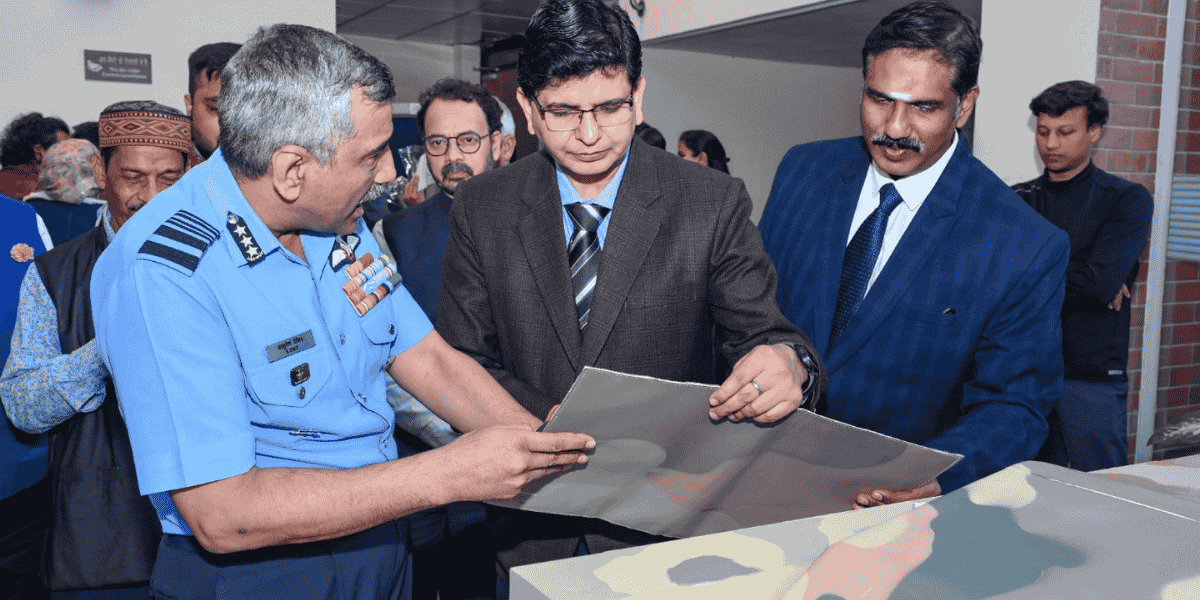By Air Marshal Anil Khosla (R)
IIT (Indian Institute of Technology) recently unveiled the Anālakṣhya Project, a ground-breaking initiative to advance metamaterial surface cloaking technology.
The project, led by researchers at IIT Kanpur, promises to enhance the strategic capabilities of the Indian defense sector by incorporating advanced technology that can protect vital equipment from detection by radar or other surveillance methods.
This innovative project aims to revolutionize defense applications by developing cloaking systems that render objects invisible or significantly reduce their detectability.
The Anālakṣhya Project utilizes metamaterials—engineered materials with properties not found in naturally occurring substances—to manipulate electromagnetic waves, thus providing new ways to conceal military assets.
The Anālakṣhya Project by IIT Kanpur represents a transformative step in India’s defense innovation and positions India at the forefront of next-generation defense systems.
Metamaterial Surface Cloaking System (MSCS)
The backbone of the Anālakṣhya project is its metamaterials, engineered to manipulate electromagnetic waves, particularly radar signals. A Metamaterial Surface Cloaking System (MSCS) is a technology that uses metamaterials to effectively “cloak” or hide objects by manipulating light or other electromagnetic waves around them.
Metamaterials are artificial materials engineered to have properties not found in naturally occurring materials. These properties often include the ability to control the propagation of electromagnetic waves, such as light, in ways that traditional materials cannot.
Traditional radars work by emitting radio waves that reflect off objects; however, metamaterials absorb or deflect these waves, significantly reducing the object’s radar cross-section (RCS).

This technology is crucial in making fighter jets, naval ships, drones, and military installations undetectable to radar-guided systems, enhancing their survivability in conflict zones.
Key Features
The system absorbs radar waves and effectively minimizes radar reflections, reducing detection probability. It features adaptive cloaking by dynamically adjusting to different radar frequencies, ensuring comprehensive stealth. Its lightweight and scalable design integrates various platforms, from drones to large platforms (Land, sea, and air).
Implications For India’s Defence Capabilities
The Anālakṣhya technology will enhance stealth operations by enabling the covert deployment of high-value military assets. Fighter jets equipped with this system could conduct missions deep into enemy territory without detection, providing a significant tactical edge.
Naval ships are often exposed in open waters, and reduced detectability will strengthen India’s maritime defense. The ability to operate undetected will boost asymmetric warfare capabilities. It will also enhance missile defense by countering radar-guided threats.
The stealth technology would allow surprise maneuvers, enhancing operational unpredictability, a critical advantage in modern warfare.
Fighter aircraft and naval vessels equipped with Anālakṣhya could operate deeper into contested regions without early detection. Integrating Anālakṣhya into multiple platforms will be a force multiplier, allowing fewer assets to achieve a more significant impact. This is particularly beneficial for missions involving long-range reconnaissance, intelligence gathering, and targeted strikes.
Anālakṣhya and India’s Defence Standing
Anālakṣhya is a testament to India’s growing emphasis on self-reliance in defense technologies (Atmanirbhar Bharat). India would reduce import dependence by developing Indigenous stealth solutions and strengthening its domestic defense industry.

The successful deployment of this technology would open avenues for India to emerge as an exporter of stealth technologies. Countries seeking advanced, cost-effective, radar-evasive solutions may consider India a viable partner. India’s cutting-edge technology development would enhance its geopolitical influence, making it an attractive partner for defense collaborations.
Challenges and Future Prospects
Adapting Anālakṣhya to various military platforms, from fighter jets to maritime and land-based platforms, requires overcoming engineering and logistical challenges. Ensuring seamless integration while maintaining operational efficiency will be a crucial focus.
Along with stealth technologies, counter-radar detection systems would also evolve. Continuous research and development will be essential to stay ahead of emerging threats.
The future of Anālakṣhya lies in its synergy with AI-driven systems, allowing real-time adjustments to stealth parameters based on changing battlefield conditions. This integration will make India’s military platforms more adaptive and autonomous.
Conclusion
The Anālakṣhya Project represents a landmark achievement for India, showcasing the country’s capability to develop state-of-the-art defense technologies. By enhancing stealth capabilities and reducing the vulnerability of critical assets, Anālakṣhya fortifies India’s national security and elevates its standing in the global defense arena.
As the technology matures, it will serve as a cornerstone for India’s future military strategies, reinforcing its role as a defense innovator and strategic power in the evolving global landscape.
- Air Marshal Anil Khosla PVSM, AVSM, VM, is a former Vice Chief of Air Staff (VCAS) of the Indian Air Force and AOC in C of Eastern Air Command.
- VIEWS PERSONAL OF THE AUTHOR
- He tweets at: @AnilKhosla16
- Email EurAsian Times at editor (at) eurasiantimes.com







